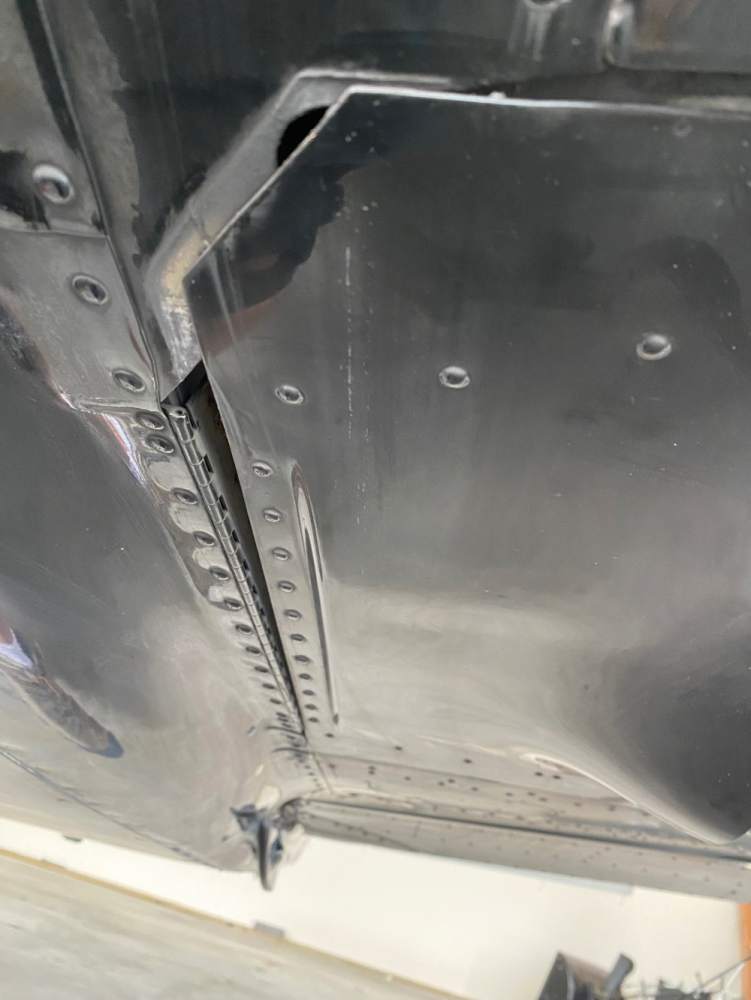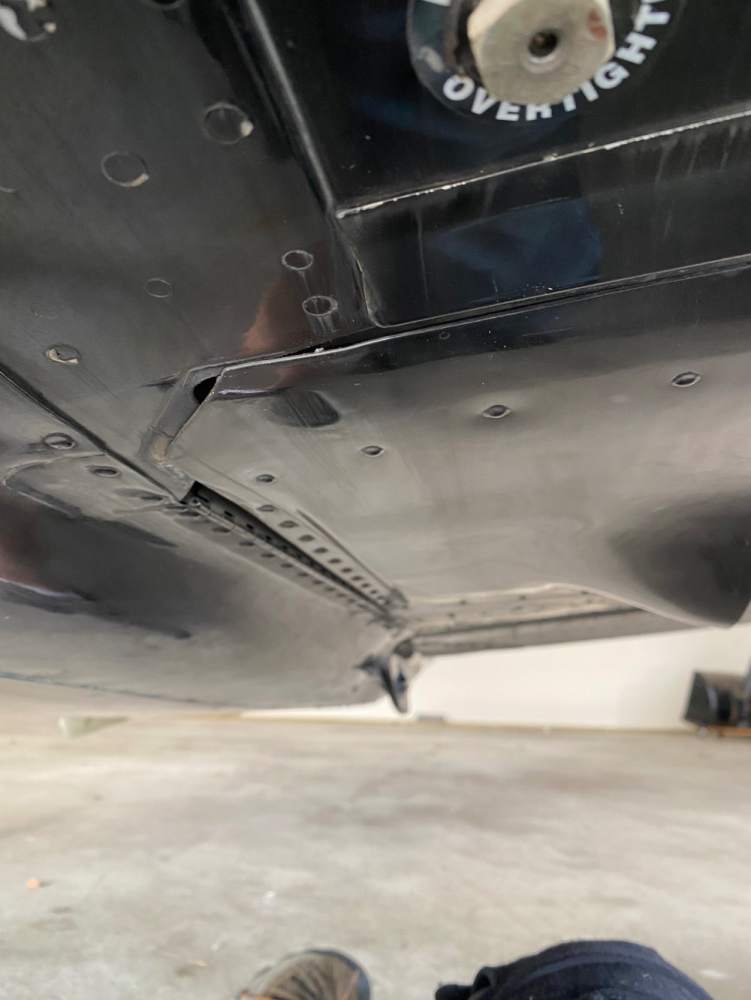-
Posts
1,595 -
Joined
-
Last visited
-
Days Won
2
Content Type
Profiles
Forums
Blogs
Gallery
Downloads
Media Demo
Events
Everything posted by exM20K
-

Flying into Midway (MDW) - should I go IFR or VFR?
exM20K replied to AndreiC's topic in Miscellaneous Aviation Talk
This… provided you’re not in the Bravo. VFR into Midway is no big deal. Heck, there’s an active flight school on the field. -dan -

Ice on the bottom of the wings. Go or no go?
exM20K replied to rwabdu's topic in General Mooney Talk
I would be more worried about fouling the gear rigging than anything else. If you bend just one rod or bellcrank, everything downstream is disturbed. This seemingly minor misalignment on the gear door took 30 hours to fix and featured a bent bellcrank and rod. Thankfully, Mooney had the bellcrank, and the shop was able to straighten the rod. So, I’m a No Go on this one. -dan -
TKS is corrosive for sure. I had a spot on the leading edge inboard bottom of one horizontal stabilizers, just aft of the panel. I’m good about spraying Corrosion. Inside the tail after a TKS flight. I’ve heard reports of others, too. No big deal, but you have to stay on top of it. Bonanza and baron wing spars with their piano hinge fastening also require close monitoring. I don’t recall the corrosion mechanism exactly, but I believe it has something to do with the hydrotropic nature of the fluid entraining water on surfaces. The pink RV antifreeze is made of propylene glycol, which is non-corrosive and pet/wildlife safe for incidental contact. TKS fluid is nasty stuff, and I’ve become increasingly mindful in using off-label or handling it. -dan
-
A garden sprayer with RV antifreeze would be a cheaper and environmentally safer option. -dan
-
I have a big Bogert universal towbar that I would like to use on the Mooney. But for the life of me, I can’t figure out the angles to back it with the towbar on the back of the tractor and the steer axle on the front. I just spent probably 20-30 mins trying. Im pretty capable backing a trailer with a truck or motorhome, but this has me baffled. Tips? Of course, putting a receiver on the front is an option, but I also use this tractor for snow removal. Thanks in advance. -dan
-
Yes, and the VC’s certainly don’t still have the Boeing stock they received, and the founders probably also sold after a very painful AMT owie. My comment is a sarcastic lament on what was likely a very poor exit for some good people and the obvious risk of Garmin buying it to kill it or combine it with their product. It makes business sense for Garmin, and they certainly have the juice to do it. -dan
-
Maybe Tyson and the other founders/investors can just give Boeing back the shares they received in March, 2019 (ouch!), resume their ownership of the business, and call it a lesson learned. That would be a better outcome than if Garmin bought it to bury it. -dan
-
Likewise, our homeowner’s insurance in Florida tripled in 2023 as all but one name exited the market. Why did they exit? Fraud, mostly, and not hurricanes, which are pretty well baked into the cake by the actuaries. What it is is fraud, especially roof damage claims filed by criminal roofing contractors who were taking advantage of assignment of benefit agreements being, well, assignable. Inflate the claim, absorb the deductible, and win/win for property owner and contractor. Not so much for the insurance company. I don’t have the source material handy, but I read that in 2021 or 2022, of the dozen or so companies underwriting homeowners’ policies, only one made money. The economics of suing a stack of contractors over $10,000 to $30,0000 roof jobs isn’t very good. The Florida legislature did put a stop to the assignment of benefits stuff, and we were pleasantly surprised that our current-year policy reverted to the old rate with a new entrant into the market. My son, who is a meteorology student, is involved in a company/project that packages soundings, radar imagery, and other stuff for insurance companies to help validate or invalidate hail claims. Whatever fraud can be ironed out of the system benefits the honest players, though not at the expense of wrongly denied coverage, one would hope. -dan
-

Where and how to adjust K-factor for fuel flow sensor in G1000?
exM20K replied to dkkim73's topic in Modern Mooney Discussion
Attitude matters a lot here. Since we are generally running the tanks down towards the end of a flight, and pitching down, the gauges read low and the warning on G1000 and on the annunciator panel annunciate early. In level flight, the G1000 warns at 10 gallons remaining, and the annunciator panel goes off at 8. Like many of you, I try to land with 10/10 gallons L/R minimum. . @dkkim73 I wouldn’t throw a bunch of $ at this. My indicated fuel flows are maybe 0.5-0.75 less than book @50 LOP, yet somehow I have an extra gallon or 2 onboard when I fill up. Close enough. -dan -
As is the absence of a vacuum system. Vacuum pump failures in IMC are significantly more serious than alternator failures. -dan
-
Mostly correct, though I believe the panels are the same kit. Also FIKI requires 28V electrics, and no-hazard may retain the heated prop in lieu of the slinger. -dan
-
This. There will be good years and bad years in piston ownership. The good years are "Fair" with respect to availability, and the bad years can see a plane unavailable for a quarter, half, or the full year. Many chose to avoid flying pistons at night / IMC over terrain / LIFR / Icing / Convective WX. If you adopt these personal limits, your available flying days may be fewer than you expect or need. Turbines are significantly better in both MX and WX respects. If you have decent airline connectivity for your 80% trip, then that is a viable work-around. If not, you and those reliant on your being somewhere at a given time will sour on serious use of these toy airplanes. -dan
-
@CAV Ice may have some guidance for an add-on heated stall switch, but the FIKI one is the only one I’ve seen. It appears to be dipped in some material that has the heating elements embedded, and it is not obvious how one could do that to the existing switch. It is a pity that a heated AOA cannot be substituted for this inferior device. Maybe that’s something the new head at AOPA can push. -dan
-
Pricing that would make even Hartzell blush.
-
The heated FIKI units are different. They sit on top of the panel. Even if you could make it work, I strongly discourage having anything to do with the vendor, Safe Flight Instrument in White Plains, NY. They charge $3500+ for overhaul, which takes 30 days. But the cherry on top was getting the hull I sent them back not once, but twice, still in a malfunctioning state. The first return they said, “function check OK. $410 diagnosis fee.” We’ll, the issue was that it wouldn’t *not* function. In the end, they relented and sent a new unit. This took months, and access to the wiring harness/plugs is via a riveted panel, which must be drilled out.
-
Just make sure of what accessories are included in each. The Continental O/H includes a comprehensive set of stuff. Now, if you have a 300 hour old turbo, exhaust, starter adapter, whatever, maybe the soup-to-nuts new doesn’t add value. That said….. Price differences in the 10-20 AMU range will be lost in the sands of time if you will own the plane for another N years/hours. Surely more so than getting the overhaul you want by the shop you want. -dan
-
Wiggle lightly. I caught one loose on my 231 and was able to save it and the panel it sits on. -dan
-
Keep it in the plane for when a TKS stall strip breaks loose. NB: “When,” not “If.” Enjoy your trip. -dan
-
Or better yet, hire someone who knows what they’re doing. You may find going west to be less hassle and sufficiently short legs to do it without ferry tanks. Depending on where in Asia the plane is, westbound is maybe 30% longer. I sent 3 DA42’s and a bunch of DA20’s to China 15 years ago. The twins flew east from the USA with no ferry tanks, and the DA20’s went on a ship in a container. -dan
-
No offense taken, and no apology warranted. Seth is the guy who machines cylinders for Gann and other well-regarded engine shops. His website is herePerformance Aircraft. Really personable guy. He ports, polishes, balances, and grinds the valve seats with precision. His work will void the CMI warranty, but really, who cares? If a cylinder has to come off my Acclaim, it’s potentially a new V-band clamp plus all the labor. In my dream world, I’ll buy an engine core, send it to Gann, Powermaster, Victor, or similar, and have them build me an engine to a higher standard that I can swap on my schedule. But with a little luck and frequent flying, that is a few years away. For now, I just topped a 1750 hour engine, which might seem nuts to some, but it works for me (I hope). I’m not planning on selling the Acclaim any time soon, so a top not being accretive to the plane’s value matters little to me. -dan
-
I carry 100 gallons of our cheap fuel out of here, so that’s a 1% solution. Or, I’m a one percenter lol. -dan






